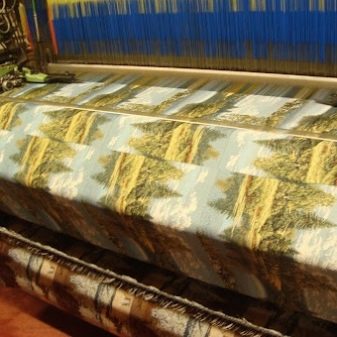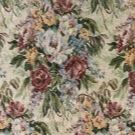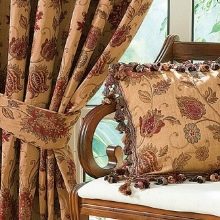Tapestry fabric

Tapestry is a material that has been known since the days of the ancient Egyptian pharaohs. But the fabric received its modern name only in the 17th century thanks to two French brothers named Gobelin. It was they who founded their own manufactory for the production of canvases with various patterns.

Now there are several varieties of material, each of which has individual characteristics. In order for the material to retain its original properties, it is necessary not only to choose it correctly, but also then to take proper care of the products.


What it is?
Tapestry is a material that is created by cross-weaving threads. The peculiarity lies in the fact that directly at the stage of production of the canvas, a pattern is formed on it. In the production of this material, the technique of jacquard weaving is used. The weft thread remains standard, as in the manufacture of other fabrics, but there are several warp threads, due to which the desired effect is achieved. Different yarn thicknesses are responsible for the structure of the patterns.
Tapestry consists of natural and synthetic fibers, among which are the following:
- acrylic;
- polyester;
- viscose;
- silk;
- cotton;
- wool.


The material has a number of unique properties. The most important of these are the following.
- Density - an important property that affects the performance: wear resistance, crease, strength. Based on the density, the scope of application of the material is further determined. For example, for upholstering upholstered furniture, creating covers and bedspreads, a fabric is used, the density range of which varies from 250 to 350 g / sq. m.For sewing clothes, thin material with a density not exceeding 180 g / sq. Is more suitable. m.
- Wrinkle. The peculiarity of the tapestry is that it almost never wrinkles. This is possible due to the density, as well as the special way of weaving the warp and weft threads.
- Color fastness Is another unique property of tapestry. Dyed synthetic threads are responsible for it. Loss of color occurs directly with prolonged exposure to direct sunlight.
Another property is shrinkage and tension. These unfavorable factors manifest themselves only in the case of improper care of the material, as well as things made from it.

Varieties
First of all, the material is distinguished by its color and the created pattern. There are the following options: plain-colored, mottled, with large and small ornaments, with a pattern that looks like embroidery. There is also a classification by size. Conventionally, tapestry can be divided into three broad categories if we take into account its structure.
So, it can be one-layer, two-layer and three-layer.
- Single layer. The single-layer material is lightweight. It is made by weaving thin warp and weft threads. In production, the one-sided weaving method is most often used.
- Two-layer. Compared to the first option, the two-layer is denser and heavier in weight. Here tapestry fabric can be either one-sided or double-sided. For creation, denser threads are used.
- Three-layer. It is the heaviest material in terms of weight, which to a greater extent possesses such properties as wear resistance, crease resistance, density. For creation, threads of increased density are used.



Manufacturers
Domestic manufacturers are especially popular in Russia. Their products are of good quality and relatively low cost. The most popular Russian manufacturing companies are listed below.
- GobelinGlavSnab is a Moscow company whose products are most often found on store shelves. The products are of high quality and inexpensive.
- "Decortex" from Vladimir.
- The company MM "Decor" from the city of Ivanovo.
- Moscow weaving and finishing plant.
If we talk about foreign manufacturers, then the products of Italian and Chinese firms are more popular than others.






How to choose?
In order to choose a tapestry fabric, you must take into account all the pros and cons of this material. The study of properties should start with the positive aspects, which are as follows:
- beauty of patterns and variety of shades;
- texture and durability;
- functionality and high tactile qualities;
- strength;
- external attractiveness.

There are also disadvantages. Among the most important of these should be noted the heavy weight and rigidity, due to which the material does not actually drape. When purchasing a tapestry in a store, you should pay attention to the quality of both the material itself and the applied pattern.
If the canvas is monochromatic (blue, red, green), then the color should be distributed as evenly as possible. You need to purchase tapestry and products from it in proven retail outlets and stores.
You should also pay attention to the cost. It should not be too low or unreasonably high.



Application area
Due to the large number of positive properties, tapestry is often used in various industries. These include the following.
- First of all, tapestry is used for sewing clothes and accessories. A predominantly thin and light tapestry is involved in this area. Dresses, shirts, trousers, stoles, bags and much more are sewn from it. Products, like the material itself, have increased wear resistance.
- Tapestry is actively used in the production of upholstered furniture.This includes sofas, armchairs, chairs, banquets, and more. The material is directly involved in the quality of the upholstery. The furniture is not only of high quality, but also beautiful.
- In the production of home accessories. This includes bedspreads, curtains, tablecloths. There are also tapestry paintings. They are lower in cost than usual, and in beauty they are in no way inferior to them.
- Tapestry material is very often purchased in order to replace upholstery on upholstered furniture of different formats.
Also, floor and wall carpets are made from raw materials of increased strength.



How to care?
In order for tapestry products not to lose their original properties, it is necessary to carry out correct and high-quality care for them. There are several important nuances here.
- The tapestry is not recommended to be washed or ironed. But if clothes are made from the material, then you cannot do without it. In this case, it is necessary to wash only by hand in a water-soap solution. Do not use aggressive powders and gels, as they can damage not only the density, but also the pattern of the fabric. If the clothes are wrinkled and need to be ironed, then it is recommended to do this at a temperature not exceeding 150 degrees. It is better not to use steaming.
- If possible, tapestry products are not washed, but a dry cleaning method is used. For this purpose, it is recommended to use a soft bristled brush as well as a vacuum cleaner.
- If stubborn stains occur, it is best to take your tapestry products to a dry cleaner. There, the material will be processed in a gentle way.
- It is not recommended to expose the tapestry to prolonged exposure to moisture, as it negatively affects the pattern. If liquid gets on the fabric or the finished product, it should be immediately removed by blotting with a sponge or cloth, and then dried naturally. If this is not done in a timely manner, the drawing may be damaged.
- For storing tapestry, it is best to use dark and dry rooms in which air circulation is not disturbed. Otherwise, mold may form on the material due to dampness.
- With prolonged storage, folds form on the fabric, which then have to be smoothed out for a rather long time. In order to avoid them, it is recommended to roll up tapestry products for storage.
- You can dry the tapestry in the usual way. This is best done in a tumble dryer. It is not recommended to expose the material to prolonged exposure to sunlight, as the original color in this case will be lost.
If you follow all of the above conditions, then tapestry products will last more than one year. The most important thing is that the initial quality meets all the stated criteria and requirements.









